COLD SPRING, NY – It sits off an unassuming stretch of highway, an elegant rectangular structure, all concrete and glass, a one-time industrial warehouse transformed into a gleaming, 18,000-square-foot exhibition space. Magazzino Italian Art, which opened at the end of June 2017, was founded and built by wife-and-husband team Nancy Olnick and Giorgio Spanu to house and display selections from their collection of more than 400 works of postwar and contemporary Italian art.
.

Magazzino Italian Art, Cold Spring, New York. Courtesy of Magazzino Italian Art, New York. Photograph by Marco Anelli © 2017.
.
Not a museum, not a foundation, Magazzino—the name is the Italian word for “warehouse”—is a private art space that welcomes the public by appointment, with the mission of broadening appreciation for Italian art through exhibitions, educational programming and a research library of more than 5,000 volumes.
Located in Cold Spring, NY in Putnam County, about 15 minutes south of Dia:Beacon and across the Hudson from Storm King Art Center, Magazzino is the newest addition to the rich cultural landscape of the Hudson Valley north of New York City.
The site, designed by the Spanish architect Miguel Quismondo, incorporates the original L-shaped warehouse into a full rectangle with old and new halves connected by glass corridors that frame the fields and woods outside. Eight galleries surround an exterior courtyard—“a piazza,” Vittorio Calabrese, Magazzino’s director, called it—with a stone-lined reflecting pool that he said offers “a rest for the eyes.”
The eyes have a lot to absorb here. Magazzino’s inaugural exhibition is “Margherita Stein: Rebel With a Cause,” 71 works by 16 artists: sculptures, drawings, paintings, prints, mixed-media assemblages and large-scale installations dating from the early 1960s to the present, most never previously exhibited.
The show, curated by Olnick and Calabrese, is a tribute to Margherita Stein, a pioneering gallerist and collector whose Christian Stein Gallery—first opened in Turin and then in Milan, where it celebrated its 50th anniversary last year—featured artists associated with the Arte Povera movement. Arte Povera, which translates literally to mean “poor art,” emerged in Italy in the early 1960s when the country was becoming increasingly industrialized. Its tenets included the use of commonplace and non-traditional materials and unconventional methods as a stance against the commercialization of art.
Examples of such practices abound, in pieces made with rags, embroidery, PVC pipe, charcoal-filled burlap sacks, a raincoat and ground coffee. In a whimsical untitled work by Alighiero Boetti, from his “Bollini” (“Stickers”) series, the artist suggests a new visual vocabulary of patterns of small red, green, blue and yellow semi-circular stickers adhered to paper in non-repeating permutations.
.

"Senza titolo" by Alighiero Boetti,1970. Ink and stickers on paper. Courtesy of Magazzino Italian Art, New York. Photograph by Marco Anelli © 2017.
.
Another untitled piece, by Jannis Kounellis, consists of a pair of leather men’s dress shoes set atop a wooden pedestal. Gilberto Zorio’s Stella is a nearly-eight-foot-wide five-pointed star pierced by a javelin and balanced on a lamp that illuminates its metallic façade. Pier Paolo Calzolari attached a refrigerator motor to a sheet of copper to create Senza titolo (Omaggio a Fontana) (Untitled [Homage to Fontana]), on which water turns to ice and produces an ephemeral field of white.
.
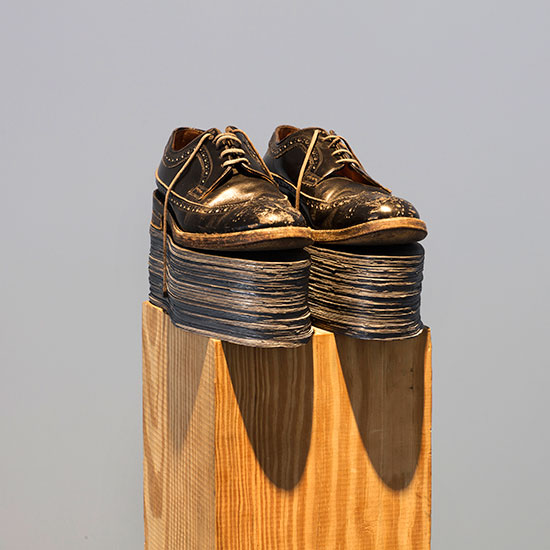
"Untitled" by Jannis Kounellis, 1989. Wood column, shoes, lead insoles. Courtesy of Magazzino Italian Art, New York. Photograph by Marco Anelli © 2017.
.
Along with their unusual materials, the works convey powerful messages, with allusions to politics, history, mythology and the natural world. Luciano Fabro’s 1971 It-alia (Italy) is a provocative examination of national identity during a period of upheaval. The mirrored sculpture takes the shape of the Italian peninsula split in two, with each section outlined in lead, one resting against the wall, the other lying on the floor. “It is referring to the leaden years of terrorism in the country,” Calabrese said. “It is Italy cut in half, broken.”
.
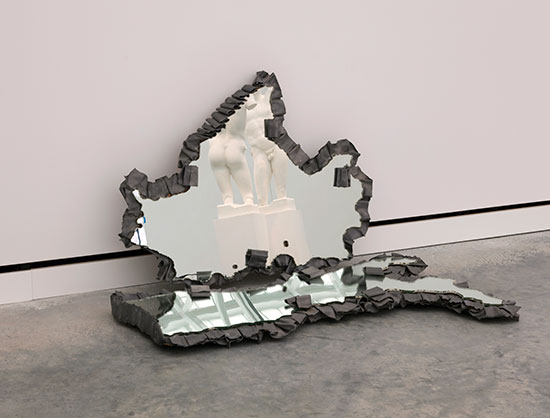
"It-alia" by Luciano Fabro, 1971. Mirror, lead on wood. Courtesy of Magazzino Italian Art, New York. Photograph by Marco Anelli © 2017.
.
Giulio Paolini’s Amore e Psiche (Cupid and Psyche) is a depiction of the romantic legend told in Apuleius’s “Metamorphoses.” In Paolini’s version, the female figure is seen from behind, her regal head and shoulders a black-and-white linear drawing printed on canvas, the rest of her an immense mass of fabrics that flow onto the floor in the colors of the spectrum. Entangled among them are empty wooden frames, which, Calabrese said, “symbolize the frustration of the artist trying to capture something.”
.
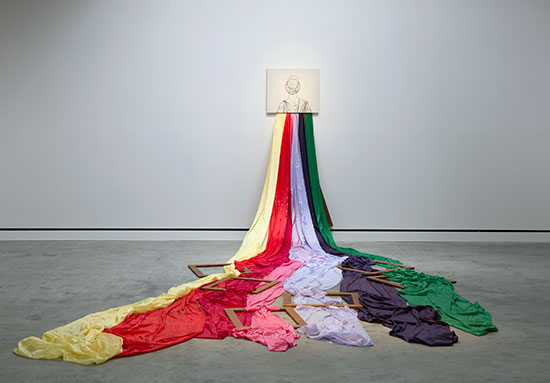
"Amore e Psiche" by Giulio Paolini, 1981. Photo emulsion on canvas, stretchers, colored fabrics
Courtesy of Magazzino Italian Art, New York. Photograph by Marco Anelli © 2017.
.
One of the earliest pieces is Michelangelo Pistoletto’s Art International (ritratto di Maximilian von Stein) (Art International [Portrait of Maximilian von Stein]), from the “Mirror Paintings” series, in which the artist applied photographic images onto planes of reflective steel. In Art International, the photograph is of Stein’s young son reading the publication “Art International,” a representation, Calabrese said, “of Stein’s mission to bring Italian art into an international discourse.”
“Rebel With a Cause” begins with a 28-minute film that introduces Stein and the artists she fostered. After meandering among works by those artists, visitors will find the final gallery filled with pieces by contemporary artists carrying on their vision. Marco Bagnoli’s unsettling Janua Coeli is a textured concave basin of polished stainless steel that draws viewers toward its mirrored surface, where they will struggle to find a coherent reflection. Lente Liquida (Liquid Lens), by Remo Salvadori, is a thick cylindrical glass urn brimming with distilled water that responds to minute vibrations in the air around it. “It holds the amount of water that is in the artist’s body,” Calabrese said.
.
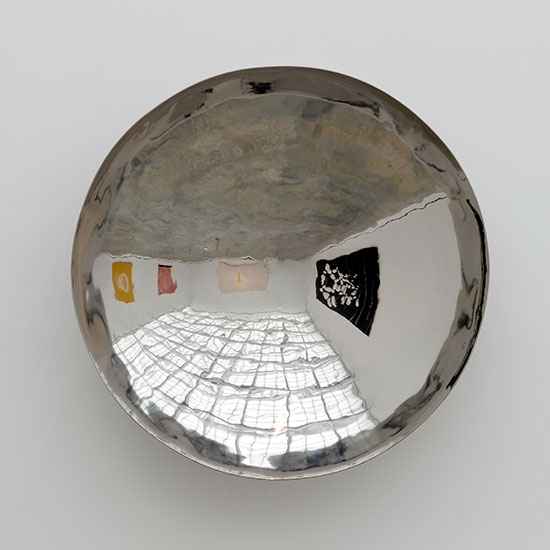
"Janua Coeli" by Marco Bagnoli, 1988-1992. Polished stainless steel. Courtesy of Magazzino Italian Art, New York. Photograph by Marco Anelli © 2017.
.
A particularly significant work by one of Arte Povera’s forerunners is Mario Merz’s From Continent to Continent, a more than five-foot-tall igloo-like structure. Its metal shell is covered with eight irregular sheets of slate, four of which hold the words of the title scripted in neon.
.
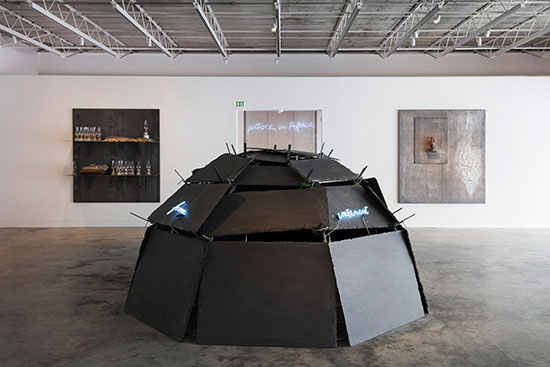
"From Continent to Continent" by Mario Merz, 1993. Slate, neon, metal structure. Courtesy of Magazzino Italian Art, New York. Photograph by Marco Anelli © 2017.
.
From Continent to Continent is one of several objects by Merz that contain neon elements, which he considered a catalyst to evoke tension between materials. The hemispherical form was iconic for him as a manifestation of the earth, the skies and the circularity of time. And, Calabrese said, “He was building a simple architectural structure that could protect you and keep you isolated from the world, and that you could pack up and bring with you, embodying the nomadic life of the artist.”
The sculpture also embodies the spirit of Magazzino itself. It was Stein’s wish that the artists she represented gain recognition in the United States. In acquiring much of Stein’s collection, and in establishing Magazzino, Olnick and Spanu took on not only Stein’s legacy but also the fulfillment of her goal. “Giorgio is Italian, Nancy is American,” Calabrese said. “The art was in Italy, now it’s here. From continent to continent: it’s the story of the collection.”
__________________________
BASIC FACTS: “Margherita Stein: Rebel With a Cause” will be on view through 2018 at Magazzino Italian Art, 2700 Route 9, Cold Spring, NY 10516. Open by appointment Thursday through Monday, 11 a.m. to 5 p.m. Admission is free. Magazzino provides free shuttle bus service from the Cold Spring train station, on Metro-North’s Hudson line from Grand Central Terminal. For appointments and more information: www.magazzino.art.
__________________________
Copyright 2017 Hamptons Art Hub LLC. All rights reserved.
